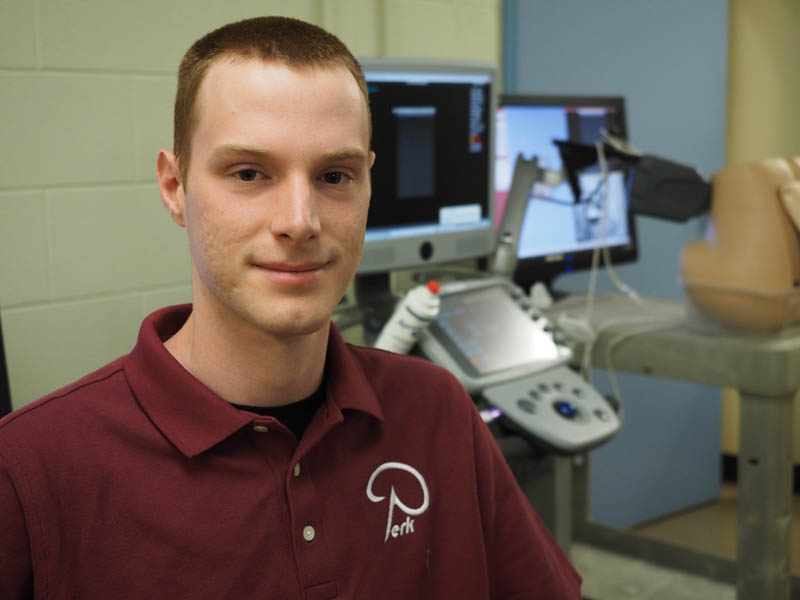Queen’s student second Canadian to receive a Link Foundation Fellowship
July 17, 2017
Share

Queen’s PhD student Matthew Holden has won a Link Foundation Fellowship in Modeling, Simulation, and Training – making Mr. Holden the second ever Canadian recipient of a Link Foundation Fellowship.
Mr. Holden studies in Queen’s School of Computing and his interdisciplinary research was recognized as a perfect fit in the context of the Link Foundation’s mission to support promising, innovative, and well-designed projects in the founders’ fields of interests.
“I am honoured to become a fellow of the Link Foundation and I am looking forward to dedicating myself fully to this research,” says Mr. Holden.
Established in 1953 by Edwin Link, inventor of the flight simulator, and his wife Marion, the Link Foundation offers awards in three major areas – energy, simulation, and ocean engineering and instrumentation research – to support doctoral students who demonstrate leadership and excellence in their respective fields. Fellowships are only available to students enrolled at U.S. or Canadian universities.
“Matthew Holden is an exemplary student and well-deserving of the recognition of the Link Foundation. His research in modeling, simulation, and training has proven to be world-class with this award,” says Gabor Fichtinger, Professor in the School of Computing with cross-appointments in Surgery, Mechanical and Materials Engineering, and Electrical and Computer Engineering.
As part of the Laboratory for Percutaneous Surgery (The Perk Lab), Mr. Holden is doing research within an interdisciplinary environment, at the intersection between certain scholarships, such as computing, education, and medicine. He’s focusing on ways to assess medical trainees’ competence and to provide them with automated feedback as part of simulation-based training for ultrasound-guided interventions. His work is timely considering the recent move at Queen's to a competency-based medical education model (CBME) across all 29 medical residency programs, as opposed to the traditional time-based model.
The time-based model assumes that a trainee practises procedures for a fixed amount of time. “This framework implies that the trainee is told, for example, ‘Practice this for one week,’ and at the end of the week, the trainee is considered competent. However, in real life, things are not so simple,” Mr. Holden says. “A competency-based model means that you have to practise the procedure until you have reached both a cognitive and technical competence benchmark.”
How should the competency of the trainees be assessed to let them progress to real patient encounters?
“This is the core question of my research,” says Mr. Holden. “In theory, we can have an expert who stands over your shoulder and watches what you are doing. Unfortunately, it is not feasible for many reasons. Alternatively, there is an option to automate the process of assessment. We can use recent medical imaging and tracking technologies to help assess these trainees automatically and relieve the burden on the experts.”
Those technologies can also be used to guide trainees through the procedure and provide them with objective feedback after the training is over. “The system will tell them, for example, ‘You scored well on this, and you can perform better by taking these steps.’ We also will use a monitor or a holographic display to visualize the anatomy and show trainees what is going on under the skin.”
Some of the technologies developed in The Perk Lab have already been adopted at the Clinical Simulation Centre at Queen’s. However, getting the training system integrated into the actual training setting may be challenging due to the guidelines associated with medical training.
“There are already a lot of frameworks and guidelines about how medical personnel should be trained and the competencies they should achieve. Researchers in the field need to think about that when designing training systems.”
Mr. Holden credits his colleagues for his success, speaking gratefully about the supportive and encouraging atmosphere in The Perk Lab. “Computers are nice because they behave predictably. You tell them to do something, and they do something,” he says, smiling. “But the key is that we can work together in the lab. We have a great team with diverse skills and act collaboratively.”
Mr. Holden prefers to use ultrasound as a big imaging modality for many reasons. “While operating with ultrasound you can act in real time, see images immediately, and guide some medical instruments like a needle to a particular target. Ultrasound is not harmful to a patient and not expensive. Yet, I am trying not to be short-sighted. Perhaps in 10 years there will be another imaging modelling that will be even better than ultrasound. New applications are always developing, and researchers in the field will always have new things to train people for.”
More information on the Link Foundation Fellowship is available on the foundation’s website.
This story was adapted from a story by Natalia Mukhina, School of Graduate Studies.